15+ Sample Laboratory Incident Report
-
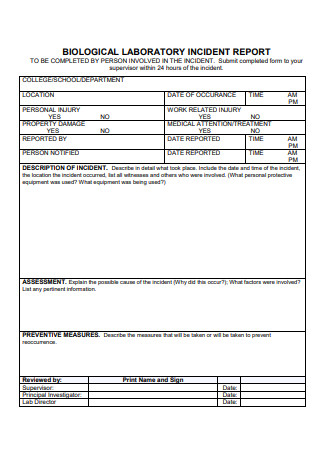
Biological Laboratory Incident Report
download now -
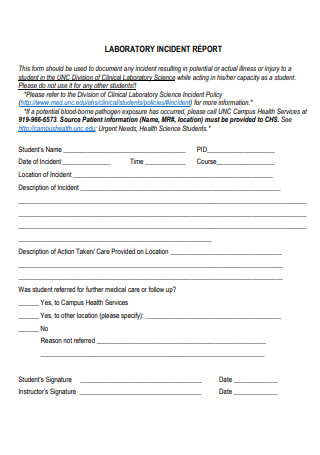
Basic Laboratory Incident Report
download now -
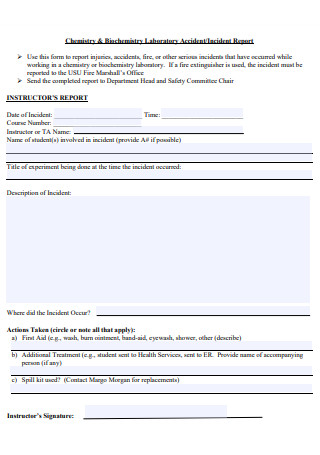
Chemistry and Biochemistry Laboratory Incident Report
download now -
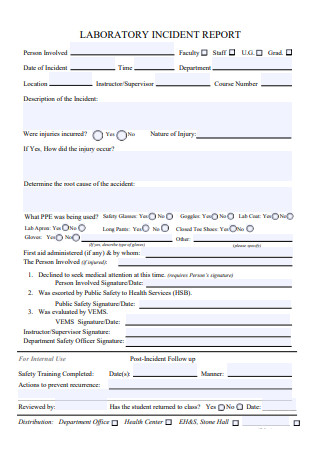
Laboratory Incident Report Example
download now -
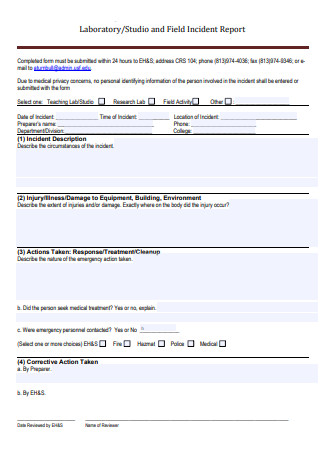
Laboratory Studio and Field Incident Report
download now -

Laboratory Incident Report Form
download now -

Science Department Laboratory Incident Report
download now -

Sample Laboratory Incident Report
download now -
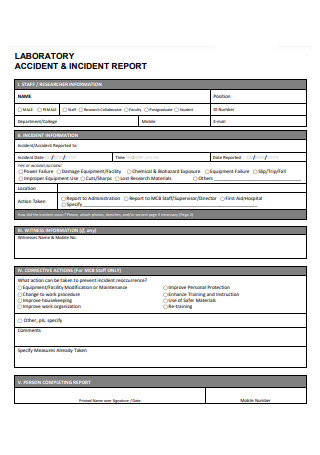
Laboratory Accident and Incident Report
download now -
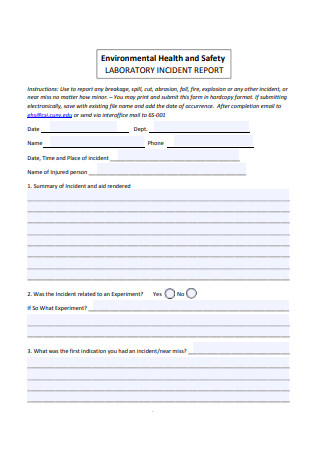
Environmental Health and Safety Laboratory Incident Report
download now -
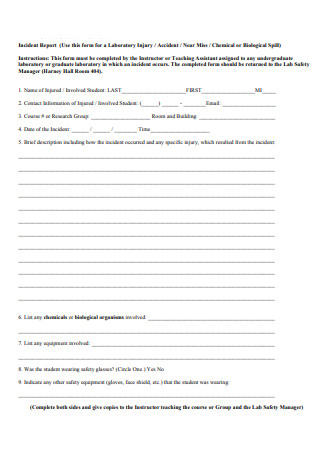
Laboratory Injury Incident Report
download now -
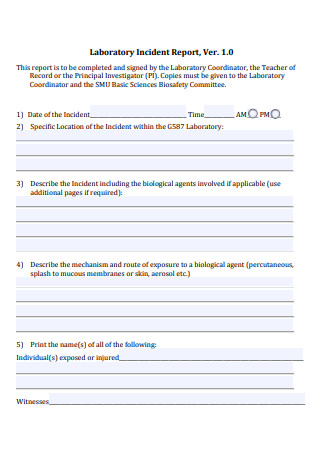
Laboratory Incident Report in PDF
download now -
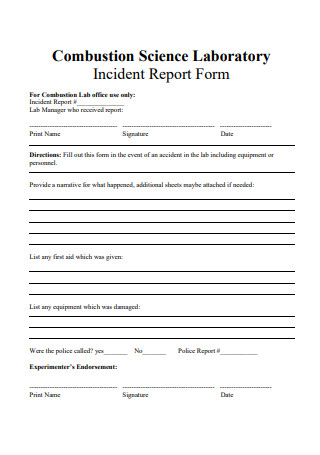
Combustion Science Laboratory Incident Report
download now -
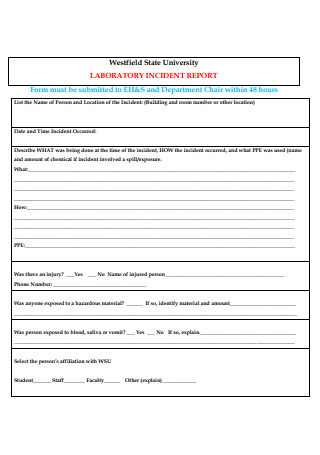
Formal Laboratory Incident Report
download now -
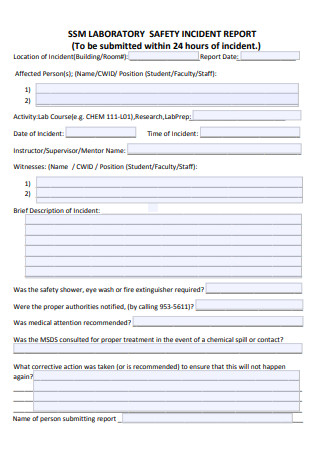
Laboratory Safety Incident Report
download now -
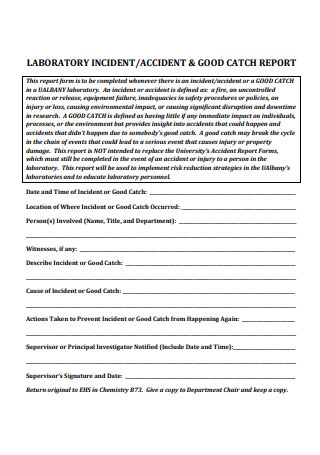
Standard Laboratory Incident Report
download now
FREE Laboratory Incident Report s to Download
15+ Sample Laboratory Incident Report
What Is A Laboratory Accident Report?
What Are The Common Laboratory Accidents?
Procedure for Laboratory Accident Event
How To Write a Good Laboratory Accident Report
FAQs
When Do You Submit a Lab Accident Report?
What Is The Standard Operating Procedure for Handling Laboratory Accidents?
Can You Write a Lab Accident Report in PDF?
Why Are Laboratory Accidents, Incidents, and Near Misses Important?
What Is A Laboratory Accident Report?
Laboratory accidents which include exposure, injuries, spills, leaks, and alteration of data analysis should be reported as soon as the incident takes place. Although we cannot predict these circumstances, it is best that facilities with laboratories should keep a laboratory accident report form. Such accidents or incidents must be taken an action by reporting it in detail to the faculty member, the department head, and to the environmental health and safety. After reporting such an incident, the environmental health and safety investigate after receiving a call or after they are notified by the emergency personnel. Within 48 hours the Lab incident report form must be completed and submitted efficiently. If the accident or incident caused serious injury and damage, a Notice of Injury form must also be filed along with the laboratory accident report.
What Are The Common Laboratory Accidents?
Accidents are the unforeseen scenario that does not happen on a daily basis. These accidents that happen inside the laboratory may occur during an analysis of a specimen such as stools, urine, blood, mucous, saliva, and more. Laboratory accidents may be discovered during analysis or after the analysis which may greatly affect the data quality or the efficacy of the results. Listed below are the common laboratory accidents that may happen from time to time:
1. Human Errors
We cannot deny the fact that we humans make mistakes. We make errors that sometimes we cannot even notice. These errors are one of the many reasons why there are lab results that are mixed up or even have corrections with them that may lead to a misdiagnosis. There are examples and illustrations that may definitely describe what is a human error. These human errors include wrong weight taken, the wrong solution prepared, wrong selection of instrument method, and lack of training. Taking the wrong and error data can be a reason for an accident inside the laboratory.
Let us take the RT-PCR test as an example wherein medical technologists will get mucous in the innermost part of your nose that connects to your throat. There are instances that if these data are being analyzed in the laboratory and a lot of data are being studied, confusion or a mixed-up of results may occur that leads to more complications for the patient. When a solution is prepared but it is not taken care of or the medical personnel did not read the name of the solution, there is a tendency that the result may be altered and adverse reactions to the patient may happen impulsively. On the other hand, the lack of training of personnel especially those who will be handling specimens from the patients may lead to an accident. Training of medical staff should adhere and properly imposed this is to reduce the risk of accidents that may lead to future complications to the client.
2. Instrument Errors
This type of error is common to the facility where systems are broken. Such examples are system suitability failure, bracketing standard failure, column leakage, connectivity failure, power failure. This can also be unforeseeable since the institution does not hold any power over the systems that are not theirs. Like for example, the connectivity failure, there are possibilities that the main source of the connectivity inside a facility with a laboratory is the said problems of disabling the connection. Moreover, with regards to the power failure, we cannot deny the fact that sometimes there is a power outage in which can be a hindrance especially when there is data being analyzed at the moment. These common errors or hindrances can be the reason why such laboratory accidents may happen.
3. Method Errors
With the first 2 laboratory accidents and errors, it is more like the most common reasons why laboratory accidents happen and may unknowingly occur. Now, this last laboratory error or accident is still one of the common in which it includes the poor column performance, diluent or mobile phase ratio, and distorted peak. Although these things are not really familiar to all people these are still the common reason why a laboratory accident may happen.
Procedure for Laboratory Accident Event
If there will be a time that an accident has occurred inside a facility with a laboratory, it is best that if the medical personnel or any personnel present at the very moment of the accident knows how the procedure for a laboratory accident event happens. Stated below is the procedure for a laboratory accident event if such thing will occur:
How To Write a Good Laboratory Accident Report
1. Find The Necessary Facts
In writing a laboratory accident report, you have to gather all necessary data and facts. You should also record such information. The necessary data and information that you should obtain are the date, time, specific location of the accident. In addition to that, the names, job titles, and the department of employees involved as well as the immediate supervisors should also be written. The name and account of witnesses and events leading up to the accident. You should also include the exact thing that the employee or employees were doing at the moment of the accident.
Furthermore, environmental conditions and factors such as slippery floors, inadequate lighting, and noise should also be taken into account for the purpose of investigation. Circumstances such as the tasks, equipment, tools, and materials used inside the laboratory are written in the laboratory accident report. If there are specific injuries including any body part or parts that have bruises or wounds must be stated in the report as well as its nature and the extent of the injury or injuries. Include the type of treatment of injuries if such occurrence takes place in the laboratory. And, the last thing that you should look into finding necessary facts is the damage to equipment or materials that were used inside the laboratory.
2. Determine The Sequence
Based on the facts, you should be able to determine the sequence of events. It should be in detail as this can be the basis or database of the investigation. The sequence should be discussed and described in detail which includes the events leading up to the accident, the events involved in the accident, the events that immediately followed the accident. These things are essential in determining and describing the sequence of events that can serve as a solid background to the investigation. You might consider creating a diagram to show, in a simple and visually effective manner, the sequence of events related to the incident and include this in your incident report. You may also take pictures of the accident scene and include them in the report in which can somehow help the readers follow the sequence of events.
3. Analyze
The accident report should include a comprehensive data analysis of the causes of the accidents. Knowing the cause of the accident in full depth can help in the analysis of the scenario. It gives us a clearer picture of how interventions should be given. These causes include the primary cause such as a spill on the floors that leads to a slip and fall. Another cause can be a secondary cause such as employees not wearing appropriate work shoes or carrying a stack of material that blocked vision. In addition to that, other contributing factors such as burned-out light bulbs in the area can be one of the leading causes of laboratory accidents.
4. Recommend
Recommendations for corrective action might include immediate corrective action. These corrective actions may include employee training on safe work practices, preventive maintenance activities that keep equipment in good operating condition, evaluating the job procedures with required recommendations for changes, and conducting a job hazard analysis to evaluate the task for any other hazards and then train employees on these hazards.
Bearing all of these things and factors in mind can lessen medical and laboratory accidents that may alter and manipulate the results of the patients. Results are important to rule out a diagnosis, if such diagnosis is incorrect, there may be consequences and complications that a person may face and be challenged.
FAQs
When Do You Submit a Lab Accident Report?
The environmental health and safety will report to the laboratory to investigate upon notification or if called by emergency personnel. Within 48 hours the Lab Incident Report Form must be completed and submitted.
What Is The Standard Operating Procedure for Handling Laboratory Accidents?
The procedure is applicable to all accidents, incidents, or even discrepancies occurring during the analysis, calculation, Reporting, and storage of samples in Quality Control laboratories. All laboratory incidents are reportable events; not all reportable events require investigations. All reportable events must be documented, tracked, and trended.
Can You Write a Lab Accident Report in PDF?
Yes, you can create a lab accident report which you can convert to PDF. There is a template for a laboratory accident form that is for free. After accessing the free template you can convert the file to PDF.
Why Are Laboratory Accidents, Incidents, and Near Misses Important?
All laboratory accidents, incidents, and near misses are to be attended to immediately. Individuals who need medical care must be attended to as quickly as possible. In addition, all accidents, incidents, and near misses need to be documented. The documentation is used to determine when corrective action is required.
Working in the laboratory can be a great way for you to gain in-depth knowledge of science topics and apply concepts while working cooperatively. A laboratory accident report can be made of use when such an unforeseeable crisis happens and that there are injuries to a person. It can be used as proof or basis in investigating what really happens inside the laboratory. Sometimes it can be used as a legal paper in case that a lawsuit will be filed by an institution. There are a lot of templates, free and editable templates of a laboratory accident report. You just have to access and download a free form or template so that you will not have a hard time making a laboratory accident report yourself. Knowing all the factual details of the said accidents make your laboratory accident report comprehensive and reliable.
